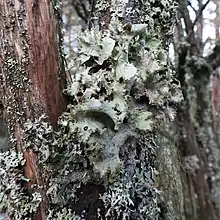| Platismatia glauca | |
|---|---|
 | |
| Scientific classification | |
| Domain: | Eukaryota |
| Kingdom: | Fungi |
| Division: | Ascomycota |
| Class: | Lecanoromycetes |
| Order: | Lecanorales |
| Family: | Parmeliaceae |
| Genus: | Platismatia |
| Species: | P. glauca |
| Binomial name | |
| Platismatia glauca | |
| Synonyms[1] | |
| |
Platismatia glauca is a common and widespread species of corticolous (bark-dwelling), foliose lichen in the family Parmeliaceae.
Taxonomy
It was first formally described by Carl Linnaeus in his 1753 work Species Plantarum.[2] William and Chicita Culberson transferred it to the genus Platismatia in 1968.[3]
Research
Platismatia glauca can acclimate to large variations in the availability of environmental nitrogen. It efficiently assimilates increased nitrogen into its thallus, increasing the size as well as the photosynthetic capabilities of its photobiont.[4]
Chemistry
Several secondary metabolites have been isolated from the lichen, including the nor-triterpene ketone, 30-nor-21α-hopan-22-one, the depsides atranorin and chloroatranorin, and the aromatic compounds methyl β-orcinolcarboxylate and chloroatranol.[5]
References
- ↑ "Synonymy. Current Name: Platismatia glauca (L.) W.L. Culb. & C.F. Culb., Contr. U.S. natnl. Herb. 34: 530 (1968)". Species Fungorum. Retrieved 21 October 2022.
- ↑ Linnaeus, Carl (1753). Species Plantarum (in Latin). Vol. 2. Stockholm: Impensis Laurentii Salvii. p. 1148.
- ↑ Culberson, William Louis; Culberson, Chicita F. (1968). The Lichen Genera Cetrelia and Platismatia (Parmeliaceae). Contributions from the United States National Herbarium. Vol. 34. Washington: Smithsonian Institution Press. pp. 449–558.
- ↑ Palmqvist, Kristin; Dahlman, Lena (2006). "Responses of the green algal foliose lichen Platismatia glauca to increased nitrogen supply". New Phytologist. 171 (2): 343–356. doi:10.1111/j.1469-8137.2006.01754.x.
- ↑ Hveding-Bergseth, Nora; Bruun, Torger; Kjøsen, Helge (1983). "Isolation of 30-nor-21 α-hopan-22-one (isoadiantone) from the lichen Platismatia glauca". Phytochemistry. 22 (8): 1826–1827. doi:10.1016/S0031-9422(00)80283-6.